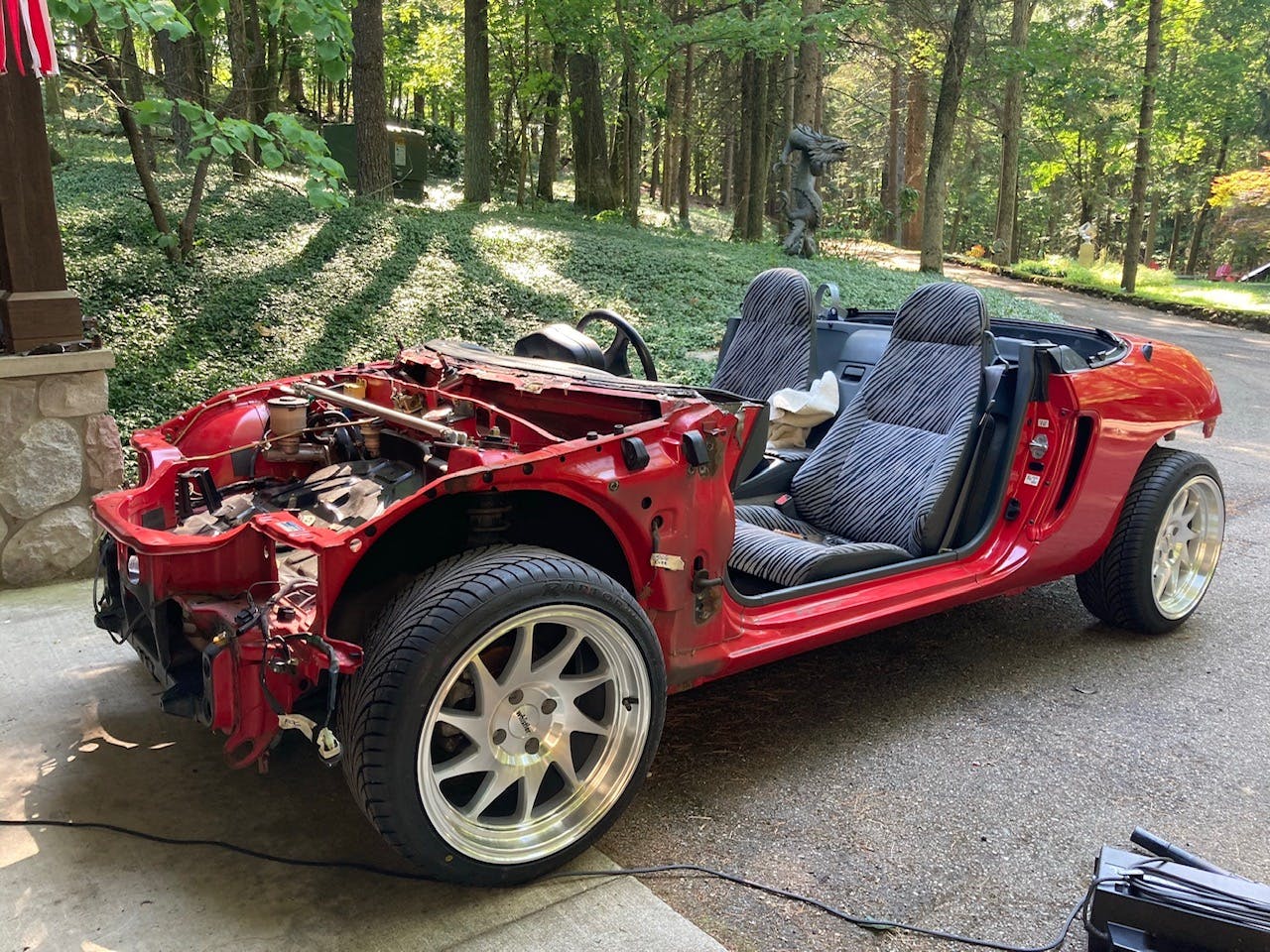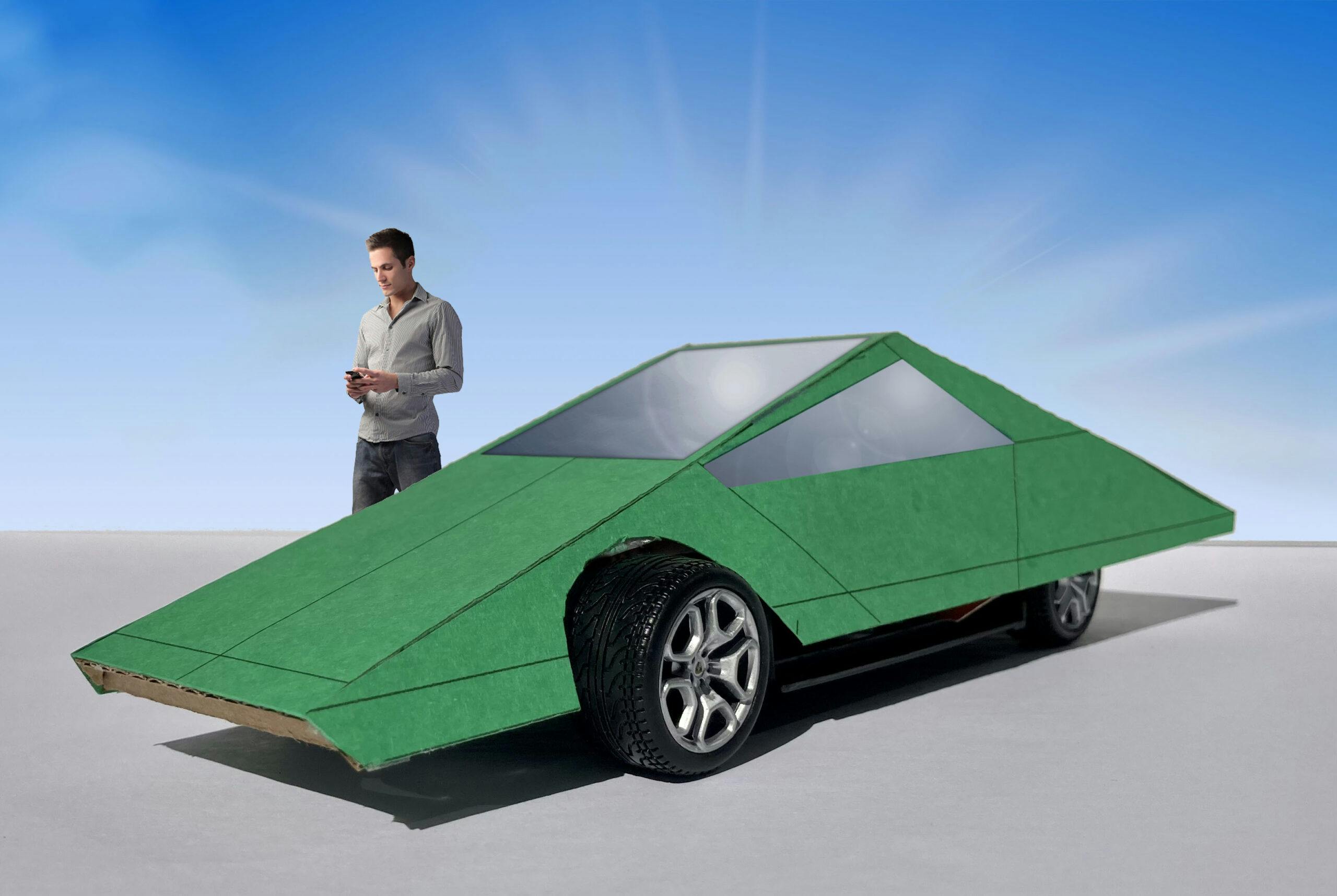Media | Articles
Homegrown: The Raazer’s edge
Welcome to Homegrown—a new limited series about homebuilt cars and the ingenuity of their visionary creators. Know a car and builder that might fit the bill? Send us an email at tips@hagerty.com with the subject line HOMEGROWN. Read about more Homegrown creations here. —Ed.
Bill Papke, 76, is a retired architect residing in Ada, Michigan. Explaining what moved him to build a car at home, he notes, “I’ve always been fascinated by concept cars, especially wedge-shaped designs. I own a replica of the 1970 Bertone Stratos Zero and also a 1990 Vector W8, both of which excel in this design genre. When Elon Musk presented his Cybertruck, I realized that I could build my own wedge car defined by four flat planes. My goal was to make it look like it had been chiseled out of a solid chunk of aluminum.”
What lies beneath Papke’s Raazer is a Honda Beat, the last car design to be approved by Soichiro Honda, Japan’s Henry Ford.
Honda began by recycling small engines in a wooden shack located in Hamamatsu. In 1948, when war-torn Japan craved transportation of any kind, Honda started selling motorized bicycles. Barely a decade later, the first Honda dealership opened in America. Soon thereafter, Honda motorcycles outsold Triumphs in England and Harley-Davidsons in the states. Today, the globe’s grandest engine producer powers everything that moves, from lawn mowers to jet aircraft.
The Honda Beat was a mid-engine two-seater originally designed by Pininfarina for urban use. Known as kei cars, these machines were powered by engines whose displacements were limited to 660cc and whose output was capped at 63 horsepower. Two years ago, Papke found just the 1991 Beat he needed for sale on Bring a Trailer. He explains: “The Beat I purchased was in excellent shape with only 42,000 kilometers on its odometer. I chose that particular car because of its short wheelbase, seating locations, and convertible body style.”

Marketplace
Buy and sell classics with confidence
The design process began with sketches, which were followed by a clay model. Papke adds, “Later I built several 1/24th scale models from my CAD drawings to match the dimensions of the Beat’s unibody chassis.
“The frame supporting my body panels is made of 1/8th-inch wall thickness aluminum extrusions cut to length on a compound miter saw. I hired a mobile welder to assemble those pieces. Another vendor used my CAD files to cut my body panels out of quarter-inch aluminum sheets with a waterjet. The flush-mounted frameless windows are 3/16-inch laminated automotive glass. The bodywork is fastened to the aluminum frame with epoxy and wrapped with titanium-colored vinyl sheeting. In addition to the $12,000 Honda Beat’s cost, I spent roughly $13,000 on materials.”

“The entire construction process took only a year. While Raazer has license plates for legal street use, I drive it only to car shows and exhibits. I’ve entered it in the sculpture category of ArtPrize, a competitive event that will occur this September in Grand Rapids, Michigan. The total prize money at stake in that event is $400,000.”
Asked what project will follow this car, which resembles one of the Great Pyramids of Giza, Papke replies: “Another wedge, of course! This time it will be an even simpler design with just three flat planes. Fewer than that is impossible. As your article’s title predicts, my next car will be called ‘Edge’.”
***
Check out the Hagerty Media homepage so you don’t miss a single story, or better yet, bookmark it. To get our best stories delivered right to your inbox, subscribe to our newsletters.






























I may not be artistic enough to appreciate this. Seeing I could reproduce this in plywood I find it lazy styling.
This is how I find the Tesla truck too., It is styling like Howard Stern Cheap and shocking. Till it’s not.
It’s very… architectural.
I don’t think I’d call a guy who has a Vector W8 lazy. I’ve met Bill and enjoy watching his collection change over the years. The first time I knew of him was seeing a Lancia Stratos on the road by his house. Then another custom kit car. Then two AutoZams were on a trailer! He is both a collector and a visionary. Cut him some slack. I’ve never done what he has and I’ve certainly never seen a car like this one!
This is a case of “to each his own”, I think. While I can appreciate the effort and determination that went into this project (so, yes, certainly not ‘lazy’) – it doesn’t appeal to me from a design or automotive excitement standpoint. Kudos to Mr. Papke, though, for having a vision and following through to realize it! As long as he likes it, who cares what others think? 👍
An acquaintance in Spokane built a similar car, though it is much more mulit-faceted, looking more like a ground bound F-117 Stealth fighter.
Used parts of the Porsche 914 suspension and a supercharged GM engine.
It sat 2-3 in tandem.
Very nice workmanship and all home built. It was useful, we accompanied it on an informal cruise to a scenic town in Idaho for lunch.
Haven’t seen it layely, but another “flat plane” car is also lurking around, so I wonder if the two are related.
Hey Don,
How about more information on the “replica of the 1970 Bertone Stratos Zero”? I know about various Stratos replicas, but not the Zero. I’m intrigued. Seeing this car at a car show sealed my future as a gearhead.
Has Mr.Musk been in touch?
So it’s the cyber coupe? It a weird sci-fi-ish thing.
This looks like several vehicles used in the Logan’s Run TV series. Or was it some other 70-80’s sci Fi series. Interesting idea.
Oh yes, I am here for a Logan’s Run reference.
My only grandson is named Logan. He caught a pass a couple of years ago (flag football) and made a nifty dash about 45 yards into the end zone by weaving around defenders and even throwing in a spin move. His dad sent us video of it, which I quickly named “Logan’s Run” and sent it out the grandson and other family members. Guess how many of them got the reference? [Hint: it’s a number lower than one…] SAD!
I would say everyone needs to watch the movie, but it’s a cult classic for good reason.
There’s a flatter quality to the clay model, note how the meatier front tires stick out. Likely adjusted to fit a driver. The rear panel needs to continue down (tailight & grey part) for at least 12 more inches for my eye. I also wonder if this design was stretched on a much longer wheelbase what that would do?
This is impressive work whether it is to one’s taste or not.
Extreme wedgie stuff does tend to look like movie prop vehicle.
Jurisidictions vary greatly on what is allowed to be homebuilt, insured and on the road –we could use a buyer’s guide on that with hints on what policy details to select… I know where I live people have a terrible time even with legacy dune buggys that have been on the same VW chassis for 50 years. Don’t even try and register a new homebuilt.
Agreed. I know what the process is and who to contact in my home state, but I’m positive that neither of those things are the same in any of the 6 surrounding states – let alone clear across the country.
…either it’s designed to deflect / reduce its radar profile, a’la the F-22 Raptor, or he’s appealing to Elon – perhaps a companion car proposal for Musk’s odd Cybertruck?!?
Registering a home built car in Michigan isn’t that difficult. All the steps are on the Secretary ot State’s web page. Basically, a police inspection to make sure you didn’t steal the parts, and a list of stuff you bought to show you paid the sales tax. I’ve done this twice. Th hardest part was getting a policeman to com and sign off. The Ann Arbor police didn’t want to be bothered, and the State guys wouldn’t do it because I was in the city. I finally got a University cop to do it. Total cost was about $25.
I dig it. Looks way better than the mid engine Ford!
….Nice…….
I prefer the Slicer model from “Gone In 60 Seconds 2” (1989). Way more functional.
Looks as good as the Tesla truck which isn’t saying much. But each to his own.
Looks like shit, but you have to respect a man who owns a Vector W8.